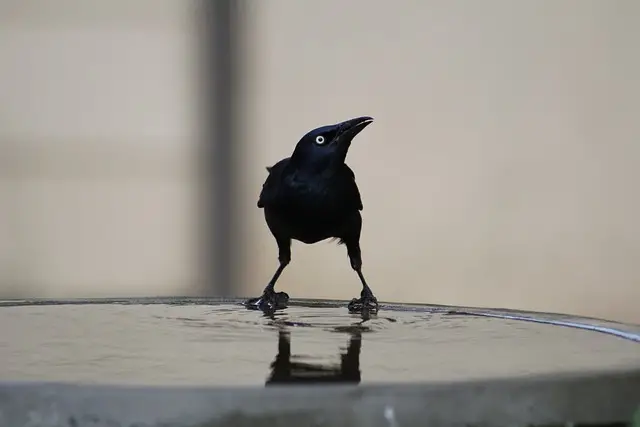The Common Grackle has frequently been referred to as the Crow Blackbird because of its black hue, huge beak, and propensity to act like a crow. It is the blackbird that goes unnoticed, is seldom recognised, and is only occasionally thought about.
Let’s not ignore this blackbird for the time being!
They occasionally may be seen strutting in the barren tree limbs when they are not making their careful journeys to the bird feeders to steal food away from new birds. You must have noticed a male grackle puffing up his feathers, partially opening his wings, and stretching his tail to appear larger than he actually is. Wonder why so?
The common grackle attempts to intimidate his rivals by puffing up his feathers as they are highly territorial. They also flaunt their abilities and try to look magnificent to attract a mating partner.
You can even catch a glimpse of them strutting, puffing up, and stubbornly dragging their tail as they struts when they are giving a courtship display.
Dig in to learn more about such interesting behavior!
Why Do Grackles Puff Up?
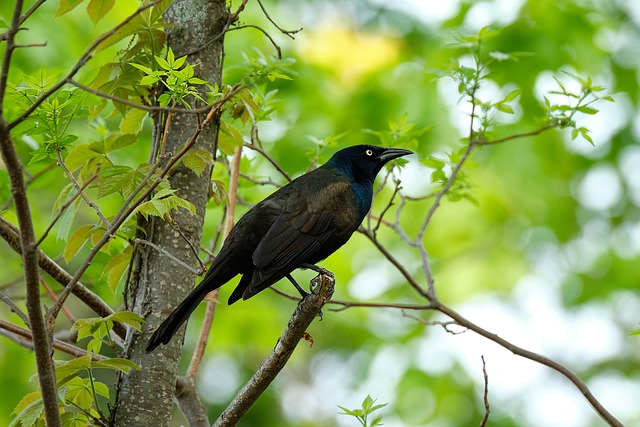
Generally, grackles puff up to show their dominance. However, they can also puff up during the breeding season to attract females.
Puffing up is a normal behavior that can be observed in a number of birds. Some birds do it to maintain the insulation of their body, others do it as a part of mating ritual.
Below are a few common reasons why common grackles engage in such behavior.
1. Show or Establish Dominance
Common grackles are highly territorial and like other territorial birds they get charged up upon the slightest sign of trespassing.
Puffing up is their way of showing how large and powerful they are.
They do that so as to deter the other birds or attackers from engaging and intruding and establishing dominance over them.
Here is a video showcasing grackles fluffing up their feathers and observing their fellow members:
2. Attract Females
Selection for mating partners is intense in avian species. A minority of attractive male birds are often able to achieve the majority of mating partners using a mating strategy that is typical of, or is believed to represent, other males of that species in polygynous species where female choice is a key factor in male reproductive success, such as in most birds.
The mating strategy of grackles include puffing up their feathers and spanning out their wings while congregating along with other male grackles who all collect to compete to attract potential mates.
Though the tune of a grackle’s song might not appeal to everyone, it’s a crucial tool for male grackles during mating season. They congregate in yards or trees, eagerly serenading potential partners with their unique melodies.
These males also showcase a peculiar behavior – puffing up and holding their heads high – which may appear odd to onlookers. You might find yourself asking, “Why do grackles look up?” This is a part of what’s known as the Bill-Up Display or Head-Held-Up Display, an essential aspect of their courtship ritual.
Why Do Grackles Look Up To The Sky?
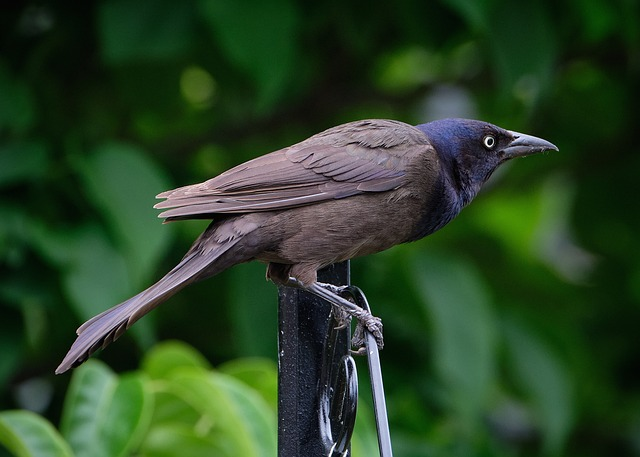
To begin with, instead of looking up, they tilt their bills. Those who own, research, or otherwise keep grackles frequently refer to this as the bill tilt.
The bill tilt is a typical mating action of male grackles engaged in courtship to attract a potential partner for mating.
Grackles look up as a result of the bill tilting behavior, which is basically used during courting. The grackles use the bill tilt to assert authority within a given feeding group because the bird that can maintain a greater bill tilt will be granted the privilege to mate with a specific female first.
Fundamentally, grackles use their propensity to gaze up to identify which male in their feeding group is the more dominant one.
The act of tilting the beak upward and gazing above makes the bird appear larger than it actually is, hence it may be considered a means for them to demonstrate that they are “better” than other grackles.
So, it is not much unique from the ways in separate species in which other male animals compete to mate with females.
It is extremely typical for male grackles to really glance up at the sky in most grackle feeding groups, as if there were anything up there.
Moreover, more than one grackle should engage in this behavior since it should be a behavior shared by other male grackles within the same feeding group.
Moreover, grackles exhibit certain behaviors as outlined below:
- The beak may either be open or shut and can occasionally tilt upwards or downwards.
- At times, their eyelids partially cover their eyes.
- Their nictitating membrane, or third eyelid, often blinks without a set rhythm.
- They typically keep their neck in a stretched-out position.
- Their body is commonly held almost vertically.
- Their breast feathers are usually sleek and shiny, but there are instances where they appear relaxed or puffed up.
- While their wings are typically folded, the tips can sometimes droop below.
At this stage, the bird has the ability to move in varying speeds and directions, or it may choose to stay motionless.
The birds’ orientation can shift, either facing each other directly or turning completely away from one another.
The courtship process among grackles commences as soon as the female grackles arrive at the breeding areas. This period is marked by pair formation, flights, and reciprocal display of puffing up behavior.
Here is a chart illustrating the different forms of pair formation in flight:
| Flight Type | Speed | Description |
| Leader Flight | Slow to moderate | A group of males closely follow a female. |
| Together Flight | Slow to moderate | Males remain ahead, to the side, behind, or below females. |
| Chase | Fast | Female tends to be evasive. |
What Is Ruff-Out Squeak In Grackles?
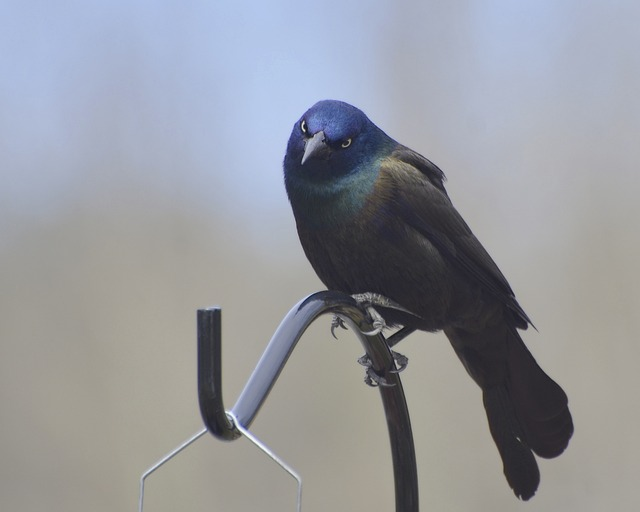
A ruff-out squeal is a raspy scream that may be heard in the courting song of male grackles, which he emits while spanning his wings out, puffing up his feathers, and leaning forward.
This happens during courtship displays when males executing their song-spread displays in front of receptive females typically congregate in groups in evergreens or other dense trees together.
Ruff-out squeak vocalisations are often broad-spectrum noises that are easy to locate, providing advantages for close proximity communication within communities of the same bird.
Male grackles use these squeals along with the display of fanning out their feathers to woo females for breeding and females produce a similar song by quivering their wings.
Are Grackles Good To Have Around?

Grackles have a negative reputation because they prefer eating crops like sorghum, wheat, and corn and also because they steal from bird feeders and irritate humans.
Yet, it turns out that grackles are capable of more than just stealing your dinner plate’s tortilla chips and squawking incredibly loudly.
The shining black birds genuinely contribute to nature and our society’s well-being in its own manner. These Texan birds consume insects naturally. They regulate insect populations, many of which are detrimental to plants. And that includes insects that may bother you if they slither on you, namely wasps and scorpions, as well as those that harm crops, including caterpillars, grasshoppers, and beetles.
Grackles are, in fact, omnivorous!
When the chance arises, they mostly consume bugs in the summer and seeds in the winter. They also occasionally consume young mice, rats, lizards, and other animals.
Because they consume insects, there will be fewer insects consuming plants.
Additionally, there is the notion that they are a component of the entire system and the web of life. They also integrate into the food web since they both consume and are eaten by other creatures.
Are Grackles Mean To Other Birds?
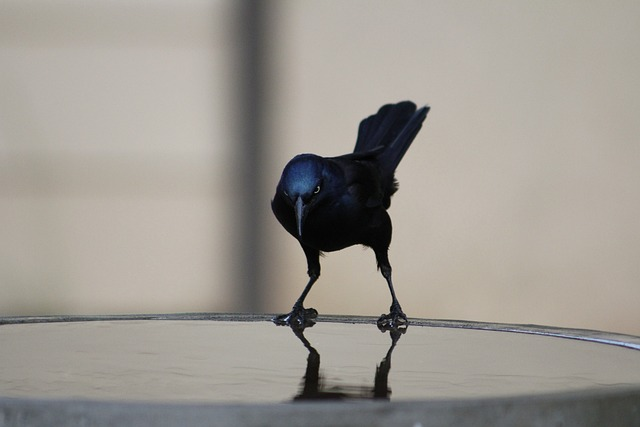
Typically, grackles are quite sociable to birds of other species.
One example of their social behavior is that common grackles that do not lay eggs in a particular season congregate in one location at night, even throughout the breeding season.
These roosts may be enormous and can house thousands of birds. Other bird species, such brown-headed cowbirds, European starlings, and red-winged blackbirds, are frequently present in them.
Despite their high levels of socialisation, common grackles may attack, assault or harass other grackles and birds of other kinds. They bite, peck, scrape, and fly at victims to assault them.
Adult common Grackles may even be meaner to the extent that they can kill and consume other adult birds in addition to eating their eggs and nestlings. They frequently consume mature house sparrows. However, they do all this in the spirit of defence.
Common grackles protect nests and the area surrounding their nest. They are particularly furious during breeding season when breeding pairs attack, chase, or dive at intruders, including people, to safeguard the nest.
What Is A Flock Of Grackles Called?
As grackles frequently gather in huge concentrations, the term “plague” or “annoyance” is sometimes used to describe their flocks. This flock formation helps them to spot birds encroaching on their area as well as predators, which swarm in order to scare away the invaders.
The formation of plague or a structured flocks of these grackles while migrating has a purpose. Scientists think that flocks raise the chances of safety and survival.
By congregating, grackles have a better chance of locating food and defending one another from danger and predators.
Sometimes, also to save energy, a large flocks of grackles fly in a “V” shape. This way the flight can be made simpler and less strenuous by the smaller birds, drawing off of each other’s one flapping wing while the other wing inside the formation does nothing, saving energy.
Why Do I Suddenly Have Grackles In My Yard?
Grackles birds are a common type of bird that can be found in both urban and rural areas. They are often seen in large flocks, gathering around food sources such as garbage dumps, feeders, and even lawns. Grackles love to eat grains and seeds, so if you have recently started feeding birds or leaving out an abundance of birdseed on your lawn, you may be attracting these unwanted visitors.
In addition to food sources, grackles will also use tall trees and structures as nesting sites. If there are tall trees or buildings near your yard, this could also be contributing to the increase in grackle activity.
However, if you want to get rid of them, the best way is by making sure they don’t have access to food.
Make sure any birdseed and other foods are put away or not accessible for them.
You can also install a barrier, such as netting, around the area in order to make it difficult for them to enter your yard.
If they do manage to get into your yard, you can try using a scarecrow or loud noises to drive them away.
It is also important to remove any potential nesting sites near your yard. Prune trees and cut back overgrown shrubs, as these are often used by grackles for nesting.
You can also install bird spikes or other deterrents on ledges and rafters in order to make it difficult for them to roost in those areas.
Why Do Grackles Squawk?
Male and female grackles use high-pitched calls when alarmed, taking flight, or approaching another grackle. Occasionally, a male grackle sitting atop a nestling colony may produce distinctive nasal calls. These vocal exchanges serve as important communication among these social birds, ensuring their safety and well-being.
Grackles also use a variety of low-pitched notes to express pleasure, excite other grackles, or even calm down younger birds. To express more emotion and excitement, grackles may use multiple vocalizations together in sequences that sound like whistling. They will often add head bobs and tail shakes as well for extra emphasis on their message.
Grackles also use quieter vocalizations, like purrs and chirps, to attract mates or as a way to show aggression. By combining various calls and displays, grackles can communicate their feelings effectively with one another.
In addition to vocal communication, grackles also communicate through physical behavior such as head nodding, tail shaking, and fluffing. These behaviors help them to express their feelings, show submission or dominance, and even ward off potential predators. By combining these behaviors with vocalizations, grackles can effectively communicate with one another to build strong social bonds.
Final Thoughts
There are several reasons that explain the puffing up behavior of common grackles. For one purpose or another, it may be to manage the temperature or to appear more magnificent.
Similar to how any animal, including people, may flex, bounce, and re-settle when they want to show off, common grackles can similarly puff up all of their feathers and rattle them to appear larger. Only that it’s more startling and dramatic in birds.
Other reasons might be that during winter months, a lot of birds puff up their feathers. The bird is kept warm by the inflated feathers and common grackles may very well be doing the same.


